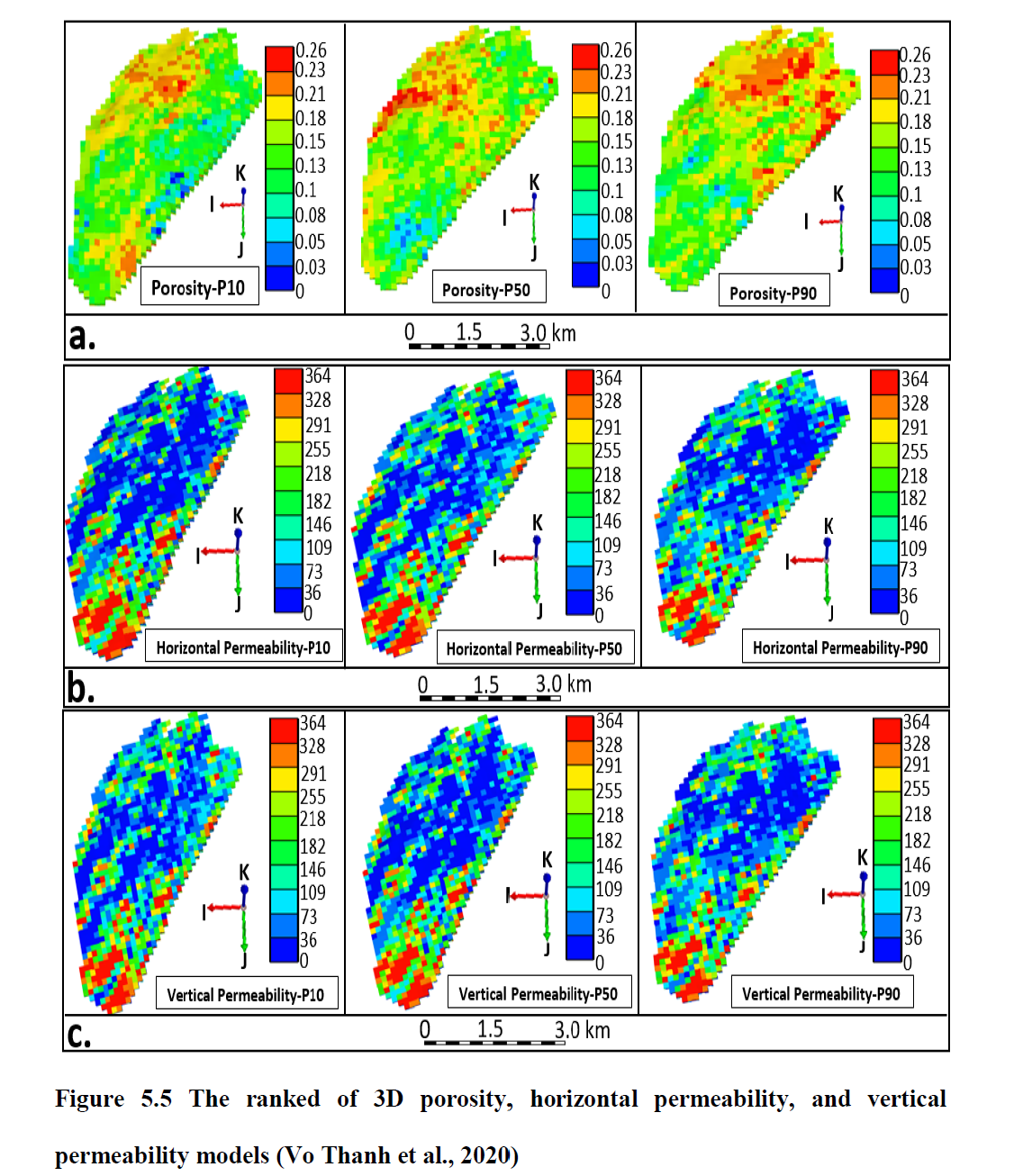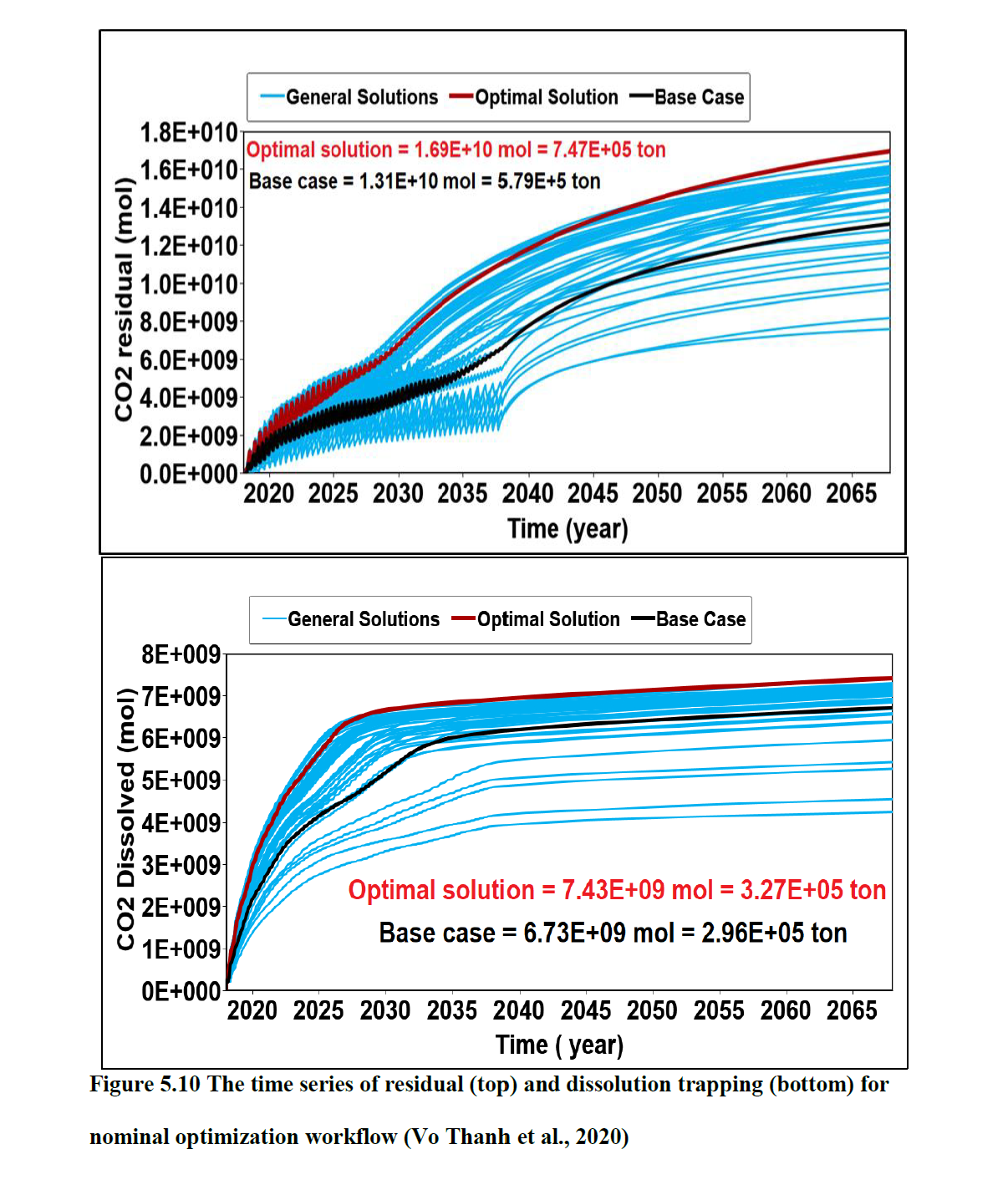INTEGRATED RESERVOIR MODELLING WORKFLOW AND OPTIMIZATION FRAMEWORK FOR CO2 SEQUESTRATION USING WATER ALTERNATING GAS PROCESS UNDER GEOLOGICAL UNCERTAINTIES
碳捕获与封存(CCS)是一种有吸引力的新兴方法,可减缓和减少温室气体的排放速度。在这方面,将碳封存在深层盐水层被认为是最合适的地点,因为它被确定为最大的储存容量。然而,为这种封存形成构建现实的三维地质模型是一个重要问题。这些封存地点的地下数据集的缺乏是建立现实模型的障碍。
此外,注入策略强烈受到二氧化碳封存效率的影响。气水交替(WAG)过程是提高EOR项目中的波及效率的常用技术。这一过程可能成为碳捕获与封存方面的一种有希望的技术。另外,建模和数值模拟是评估合理的三维模型和有效注入技术的有用工具。然而,地质不确定性(例如孔隙度和渗透率分布)对于建模和油藏模拟的结果是至关重要的因素。因此,本研究提出了一个系统的工作流程,将三维建模,油藏模拟和地质不确定性整合起来。利用现有的地下数据开发了新的模拟框架。该框架可以增强三维孔隙度和渗透率模型的准确性。此外,采用了健壮的优化方法来改善在地质不确定性下利用WAG过程进行二氧化碳封存。最终,该系统化的工作流程可以增加储存地点中存储的二氧化碳注入量的90%。
本论文包括以下六章:
第一章介绍了研究动机,背景和目标,以及论文的大纲。此外,本章介绍了有关人工神经网络,地质统计建模,气水交替的先前研究。
第二章描述了二氧化碳封存建模,地质不确定性,地质不确定性下优化以及研究区域的文献综述。本章提供了关于二氧化碳封存的地质建模和油藏模拟的详细信息。重点强调了地质风险的关键作用,重点关注地质二氧化碳封存。此外,基于先前的研究,引入了地质不确定性下的鲁棒优化。此外,介绍了研究区域,以便更好地了解越南九龙盆地中河流相砂岩油藏的特征。最后,介绍了用于更好地了解地下信息的可用数据,以进行建模和模拟研究。
第三章描述了整合地质建模工作流程的发展。采用基于对象的建模,序贯高斯模拟和人工神经网络(ANN),开发了一个名为“封装框架”的新建模工作流程,以构建南旺油田的合理三维孔隙度和渗透率模型。本章展示了封装框架构建模型的优势和方法,以及与传统框架的比较。Petrel软件包被用作基于对象的方法来构建岩相模型。此外,采用序列高斯模拟对岩相分布进行排名。然后,利用人工神经网络预测使用地震属性和测井测量的储层物理模型。为了整合排名岩相和ANN模型,使用协变式克里金法来分配最终的孔隙度和渗透率模型。此外,为了进行比较,还构建了传统模型。最后,ECLIPSE模拟器执行了钻头试验拟合,以评估新模型和传统模型之间的准确性。历史拟合结果表明,开发的孔隙度和渗透率模型对于未来的油田开发计划以及二氧化碳封存评估更好。
第四章讨论了在河流相砂岩油藏中二氧化碳封存的模拟工作流程和结果。界定问题是油藏模拟工作的第一步。然后,动态数据集被收集以导入模拟器。此外,本章进行了多个模拟场景,以评估地质因素和注入策略对二氧化碳封存的影响。进行了敏感性分析,以确定项目的合适注入速率。这一注入速率在整个工作中被用于保持模拟结果的一致性。优势通道分布和各向异性被改变以研究河流相砂岩油藏中的二氧化碳羽流的迁移。另外,进行了连续注入和WAG注入的注入策略比较,以确定有效的注入方法进行进一步的研究。模拟结果表明,与连续二氧化碳注入相比,WAG技术提高了二氧化碳的溶解和残余封存。这种增加是由于注入后由孔隙介质中的泄流和渗透过程引起的二氧化碳的迁移。因此,建议对WAG技术进行优化研究。
第五章描述了在地质不确定性下利用水替气过程进行二氧化碳封存的优化框架。采用健壮优化工作流程确定了在地质不确定性下水和气注入的最佳周期长度。总共产生了200个地质实现的三维孔隙度、水平和垂直渗透率分布,以考虑地质约束。这一工作流程的第一步是通过量化二氧化碳累积注入来对所有实现进行排名,以选择代表油藏整体不确定性的P10、P50和P90。使用CMG-GEM成分油藏模拟软件评估了水替气过程。实验设计创建了250个模拟任务,包括周期长度和地质不确定性参数。然后,利用成分油藏模拟器对生成的工作进行评估,以计算20年内的CO2存储量,之后是40年的注入后跟随年。随后,进行了健壮优化流程,以确定在考虑孔隙度、渗透率和各向异性模式的地质不确定性下高CO2封存的真正最佳解。为了比较进行了基于单个实现的名义优化。在地质不确定性下进行的健壮优化框架结果比名义实现优化结果实现了更高的二氧化碳封存。该研究建议了一种快速可靠的健壮优化工作流程,可以代表主要参数的不确定性,包括储层物理特性、地质和经济因素,用于二氧化碳封存。
第六章总结了本研究的发现,包括建议和未来项目的可能性。
Abstract
Carbon Capture and Storage (CCS) is an attractive emerging method to mitigate and slow down greenhouse gases emission. In this vein, carbon storage in deep saline aquifers is touted as the most suitable site because it is identified as the largest storage capacity. However, the construction of realistic 3D geological models for this storage formation is a significant issue. The lack of subsurface datasets in these storage sites is an obstacle to build a realistic model. Also, injection strategies are strongly influenced by CO2 sequestration efficiency. The water alternating gas (WAG) process is a common technique to improve sweep efficiency in EOR projects. This process could be a promising technique in the CCS aspect. Besides, the modelling and numerical simulation are useful tools to evaluate the reasonable 3D models and effective injection technique. However, geological uncertainties (e.g., porosity and permeability distributions) are crucial factors for modelling and reservoir simulation results.
Therefore, this study was proposed a systematic workflow to integrate 3D modelling, reservoir simulation, and geological uncertainties. The new modelling framework was developed with available subsurface data. This framework could enhance the accuracy of 3D porosity and permeability models. Also, the robust optimization approach was implemented to improve CO2 trapping using the WAG process under geological uncertainties. Ultimately, the systematic workflow could increase the 90% amount of CO2 injection stored in the storage site.
This dissertation composes of six chapters as follows:
Chapter 1 presents the research motivation, background, and objectives, as well as the outline of the dissertation. Furthermore, this chapter introduces previous studies on Artificial Neural Networks, Geostatistical modelling, Water Alternating Gas process.
Chapter 2 describes the literature review of CO2 sequestration modelling, geological uncertainties, optimization under geological uncertainty, and study area. Detail information on geological modelling and reservoir simulation of CO2 sequestration was provided in this chapter. The critical role of geological risk was highlighted, focusing on geological CO2 sequestration. Also, robust optimization under geological uncertainties was introduced based on previous studies. Furthermore, the study area was presented for a better understanding of the characteristic of fluvial sandstone reservoirs in Cuu Long Basin, Vietnam. Ultimately, the available data is introduced for a better understanding of subsurface pieces of information to conduct the modelling and simulation studies.
Chapter 3 describes the development of an integrated geological modelling workflow. Adopting the object-based modelling, Sequential Gaussian Simulation, and Artificial Neural Network (ANN), a new modelling workflow named “encapsulated framework” was developed to construct the reasonable 3D porosity and permeability models in Nam Vang field. The advantages, methodology of the encapsulated framework build the models, as well as the comparison with traditional framework, were presented in this chapter. Petrel package was employed as the object-based method to construct the lithofacies models. Also, Sequential Gaussian Simulation was adapted to rank the lithofacies distribution. Then, Artificial Neural Networks was predicted the petrophysical models using seismic attributes and well log measurement. To integrating the ranking lithofacies and ANN models, the co-kriging was used to distribute the final porosity and permeability models. Also, conventional models were constructed for comparison purposes. Finally, the ECLIPSE simulator was performed the Drill Stem Test matching to evaluate the accuracy between the new and traditional models. The results of history matching indicated that the developed porosity and permeability models are better for future field development plan as well as the CO2 sequestration assessment.
Chapter 4 discusses the simulation workflow and results of CO2 sequestration in a fluvial sandstone reservoir. The defining problems are the first step of reservoir simulation work. Then, the dynamic datasets were collected to import in the simulator. Besides, this chapter was conducted several simulation scenarios to evaluate the impact of geological factors and injection strategies for CO2 sequestration. The sensitivity analysis was performed to determine the suitable injection rate for the project. This injection rate used throughout the work for consistent simulation results. The channel distribution and anisotropy were changed to investigate the CO2 plume migration in a fluvial sandstone reservoir. Also, the injection strategies comprise continuously, and WAG injection was compared to determine the effective injection methods for further studies. The simulation results indicated that WAG technology was enhanced the solubility and residual trapping when comparing with continuous CO2 injection. This increase was due to the migration of CO2 after injection caused by drainage and imbibition processes in porous media. Therefore, the WAG technique was suggested for optimization studies.
Chapter 5 describes the optimization framework of CO2 sequestration using the Water Alternating Gas process under geological uncertainties. A robust optimization workflow was used to determine the optimal cycle length of water and gas injection under geological uncertainties. A total of 200 geological realizations of the 3D porosity, horizontal and vertical permeability distributions were generated to consider the geological constraints. The first step of this workflow is to rank all realizations by quantifying CO2 cumulative injection to select P10, P50, and P90 that represent the overall uncertainty of a reservoir. The WAG process was evaluated using CMG-GEM compositional reservoir simulation software. The experimental design created 250 simulation jobs, including the cycle length and geological uncertainty parameters. Then, the generated jobs were assessed using the compositional reservoir simulator to calculate the CO2 storage amounts by the end of 20 years-injection followings by 40 post-injection years. Subsequently, the robust optimization procedure was applied to determine the true optimal solution of the high CO2 trapping by considering the geological uncertainties in porosity, permeability, and anisotropy models. The nominal optimization based on a single realization was conducted for comparison. The proposed robust optimization workflow under geological uncertainties resulted in higher CO2 trapping than the nominal realization optimization. This study suggested a fast and reliable robust optimization workflow that can represent the uncertainties of the main parameters, including petrophysical properties, geology, and economic factor, for CO2 sequestration
Chapter 6 summarizes the conclusions of the findings of this research, including the recommendations and the possibility of a future project.





